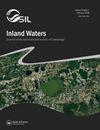Simulated impacts of climate change on Lake Simcoe water quality
IF 2.3
3区 环境科学与生态学
Q1 LIMNOLOGY
引用次数: 0
Abstract
ABSTRACT Lake Simcoe has undergone eutrophication and hypoxia since the 1960s. Climate change, leading to enhanced summer thermal stratification, has been identified as a key stressor. In this study, we modeled the impacts of climate change on hydrodynamics and biogeochemistry in Lake Simcoe by applying a 1-dimensional (vertical) model forced with A2 and B1 scenario outputs from a global climate model over 2000–2100. The model was calibrated in 2008 and validated in 2009, with maximum root mean square error (RMSE) of modelled temperature between 1.5 and 3.0 °C and dissolved oxygen RMSE between 0.5 and 2.5 mg L−1. Phytoplankton chlorophyll a was simulated with RMSE between 1.25 µg L−1 (large diatoms) and ∼0.5 µg L−1 (other groups). Interannual variability in spring water temperature and length of stratification were related to changes in the North Atlantic and Artic Oscillation indices, respectively. Under A2 and B1 forcing, the duration of stratification will increase by 45 and 38 days in summer between spring and fall turnover, respectively. The extended stratified period leads to a reduction in hypolimnetic dissolved oxygen from 3–7 to <3 mg L−1, thereby reducing the quality of cold-water fish habitat and increasing internal phosphorus loading from the benthos. These internal loads, combined with increased water temperatures, lead to increased cyanobacteria concentrations, beginning around 2070.气候变化对辛科湖水质的模拟影响
摘要自20世纪60年代以来,辛科湖经历了富营养化和缺氧。气候变化导致夏季热分层加剧,已被确定为一个关键的压力源。在这项研究中,我们通过应用2000-2100年全球气候模型的A2和B1情景输出的一维(垂直)模型,模拟了气候变化对辛科湖水动力学和生物地球化学的影响。该模型于2008年进行了校准,并于2009年进行了验证,建模温度的最大均方根误差(RMSE)在1.5之间 和3.0 °C,溶解氧RMSE在0.5和2.5之间 mg L−1。浮游植物叶绿素a的均方根误差在1.25之间 µg L−1(大型硅藻)和~0.5 µg L−1(其他组)。春季水温和分层长度的年际变化分别与北大西洋和北极涛动指数的变化有关。在A2和B1强迫下,夏季春季和秋季营业额之间的分层持续时间将分别增加45天和38天。延长的分层期导致低盐度溶解氧从3-7减少到<3 mg L−1,从而降低冷水鱼类栖息地的质量并增加海底生物的内部磷负荷。这些内部负荷,再加上水温的升高,导致蓝藻浓度的增加,从2070年左右开始。
本文章由计算机程序翻译,如有差异,请以英文原文为准。
求助全文
约1分钟内获得全文
求助全文
来源期刊

Inland Waters
LIMNOLOGY-MARINE & FRESHWATER BIOLOGY
CiteScore
6.10
自引率
9.70%
发文量
34
审稿时长
>12 weeks
期刊介绍:
Inland Waters is the peer-reviewed, scholarly outlet for original papers that advance science within the framework of the International Society of Limnology (SIL). The journal promotes understanding of inland aquatic ecosystems and their management. Subject matter parallels the content of SIL Congresses, and submissions based on presentations are encouraged.
All aspects of physical, chemical, and biological limnology are appropriate, as are papers on applied and regional limnology. The journal also aims to publish articles resulting from plenary lectures presented at SIL Congresses and occasional synthesis articles, as well as issues dedicated to a particular theme, specific water body, or aquatic ecosystem in a geographical area. Publication in the journal is not restricted to SIL members.
 求助内容:
求助内容: 应助结果提醒方式:
应助结果提醒方式:


